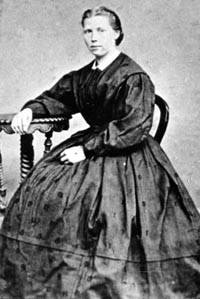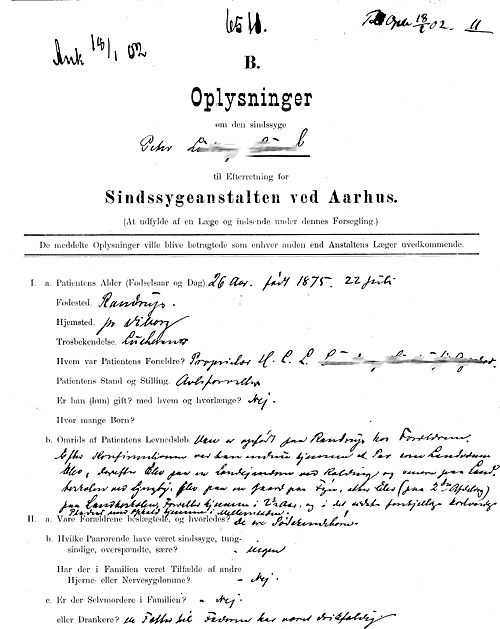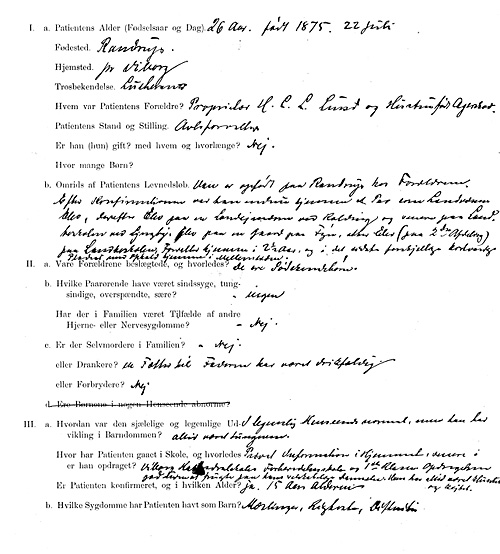Psychiatric causes .
In 1878 Selmer, in his 25 year report on the “Lunatic Asylum in Aarhus”, states that approximately half of the patients’ illnesses are caused by psychological issues, predominantly triggered by external social causes.
Selmer listed drunkenness (and masturbation) under somatic causes. But he did have his doubts about this because there is a tendency to blame one self for these “excesses” and therefore perhaps they were to be registered under psychological causes.
The hardship of daily life .
Selmer, however, regarded psychological courses as subordinate, though he did have an appreciation for the fact that marital, domestic and economic concerns and fears, by their “continuous nagging, oppressing and slowly depleting effect”, could trigger mental illnesses, with abnormal processes in the brain as a result.
Extract from list of psychological causes of mental illnesses:
• Neglected, deprived childhood
• Foolishness, spoiled in upbringing
• Spiritual overexertion, reading for an exam, devouring a novel, studies at folk high schools
• Religious awakening
• A broken heart, jealousy
• Extramarital child birth
• Loss of children and other close relatives
• Marital and domestic sorrows
• Loss of money, bankruptcy or other financial misfortunes
• Loss of employment, economic decline
• War events in 1848-50 and 1864
• Idleness, unsettledness and aimless life.
Admission procedure in 1852
When a patient was admitted, the admitting psychiatrist wrote a so-called B-form with information about the course of the disease and the patient’s former life. The head psychiatrist decided, in consultation with the board, whether the patient was to be admitted or not.
The illness must not have lasted for more than 2 years before the admittance. If it had, the patient was considered incurable. If the illness had lasted less than 3 months, the patient was admitted free of charge for 3 months. This provision was considered extremely effective not least because it had a beneficial effect of starting the treatment as soon as possible
Today, many mentally ill people have to wait until they are ill enough to be registered in the target group for mentally ill, from which the hospitals and district psychiatrists choose whom to admit There are neither staff nor resources enough for taking care of the many persons suffering from minor psychiatric disorders such as anxiety and mild depressive conditions or those who just had a hard time psychologically due to existential problems.
Patient No 5
The patients were not always content with their stay.
Patient No 5, who was a farmer’s helper from Horsens, was admitted in 1852 and died here at the hospital in 1902. He ran away several times before he accepted staying. He was admitted for having attacked an innocent bystander, the result of which was that the parish he came from was very reluctant to take him home. They wrote that they wanted him to be set to work so he could earn his own keeps and thereby the parish would save money.
All patients were guaranteed clothes, food, medical care and shelter. The hospital was to be paid either by the relatives, the local authority or the prison system.
Attendant staff
Attendant staff
At Harald Selmer’s hospital the care staff was to treat the patients as ill people with good common sense and compassion. Before a proper education for nursing staff was established at the beginning of the 2000th century, these attendants were men and women from the nearby villages and it could be hard, or sometimes impossible, for them to achieve the high standards that were set.
Patients had to work
Right from the beginning in 1852, farming became an integral part of hospital life. There was a smallholding with cereals, horses, pigs, cows and chickens. Selmer found it natural that patients in recovery should help with work in the fields, the garden and in the stable and barns, all with a therapeutic aim. This kind of work was familiar to many of the patients. They knew of it from their homes or from their trade as craftsmen. As an example, dating back before 1900, a patient took pride in making a pair of wooden shoes every single day. Weaving was also a common craft, done by men as well as women.
Statistic survey
In 1870, Selmer made an investigation into the former occupations of the admitted patients set against the number of patients represented in each of these occupation categories.
One survey was made on men, another on women.
The first occupation (nr.1) is the one with most patients represented
|
Men:
1. Civil Services
2. Business
3. Domestic servants
4. Sailors
5. Farmers
|
Women:
1. Civil Services
2. Business
3. Domestic servants
4. Trades women
5. Fishing Trade
|
Harald Selmer’s conclusion to the survey was that because the educated upper classes were more sophisticated they were more vulnerable as well.



